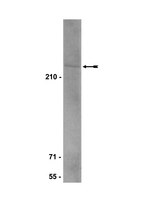BLM SUMOylation regulates ssDNA accumulation at stalled replication forks.
Ouyang, KJ; Yagle, MK; Matunis, MJ; Ellis, NA
Frontiers in genetics
4
167
2013
Mostrar resumen
Polymerase stalling results in uncoupling of DNA polymerase and the replicative helicase, which generates single-stranded DNA (ssDNA). After stalling, RAD51 accumulates at stalled replication forks to stabilize the fork and to repair by homologous recombination (HR) double-strand breaks (DSBs) that accumulate there. We showed recently that SUMO modification of the BLM helicase is required in order for RAD51 to accumulate at stalled forks. In order to investigate how BLM SUMOylation controls RAD51 accumulation, we characterized the function of HR proteins and ssDNA-binding protein RPA in cells that stably expressed either normal BLM (BLM+) or SUMO-mutant BLM (SM-BLM). In HU-treated SM-BLM cells, mediators BRCA2 and RAD52, which normally substitute RAD51 for RPA on ssDNA, failed to accumulate normally at stalled forks; instead, excess RPA accumulated. SM-BLM cells also exhibited higher levels of HU-induced chromatin-bound RPA than BLM+ cells did. The excess RPA did not result from excessive intrinsic BLM helicase activity, because in vitro SUMOylated BLM unwound similar amounts of replication-fork substrate as unSUMOylated BLM. Nor did BLM SUMOylation inhibit binding of RPA to BLM in vitro; however, in immunoprecipitation experiments, more BLM-RPA complex formed in HU-treated SM-BLM cells, indicating that BLM SUMOylation controls the amount of BLM-RPA complex normally formed at stalled forks. Together, these results showed that BLM SUMOylation regulates the amount of ssDNA that accumulates during polymerase stalling. We conclude that BLM SUMOylation functions as a licensing mechanism that permits and regulates HR at damaged replication forks. | Immunofluorescence | 24027577
 |
A human BRCA2 complex containing a structural DNA binding component influences cell cycle progression.
Marmorstein, L Y, et al.
Cell, 104: 247-57 (2001)
2001
Mostrar resumen
Germline mutations of the human BRCA2 gene confer susceptibility to breast cancer. Although the function of the BRCA2 protein remains to be determined, murine cells homozygous for BRCA2 inactivation display chromosomal aberrations. We have isolated a 2 MDa BRCA2-containing complex and identified a structural DNA binding component, designated as BRCA2-Associated Factor 35 (BRAF35). BRAF35 contains a nonspecific DNA binding HMG domain and a kinesin-like coiled coil domain. Similar to BRCA2, BRAF35 mRNA expression levels in mouse embryos are highest in proliferating tissues with high mitotic index. Strikingly, nuclear staining revealed a close association of BRAF35/BRCA2 complex with condensed chromatin coincident with histone H3 phosphorylation. Importantly, antibody microinjection experiments suggest a role for BRCA2/BRAF35 complex in modulation of cell cycle progression. | | 11207365
 |
Accurate transcription initiation by RNA polymerase II in a soluble extract from isolated mammalian nuclei.
Dignam, J D, et al.
Nucleic Acids Res., 11: 1475-89 (1983)
1982
Mostrar resumen
We have developed a procedure for preparing extracts from nuclei of human tissue culture cells that directs accurate transcription initiation in vitro from class II promoters. Conditions of extraction and assay have been optimized for maximum activity using the major late promoter of adenovirus 2. The extract also directs accurate transcription initiation from other adenovirus promoters and cellular promoters. The extract also directs accurate transcription initiation from class III promoters (tRNA and Ad 2 VA). | | 6828386
 |










